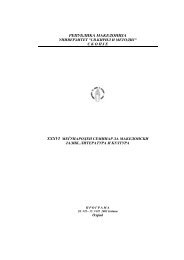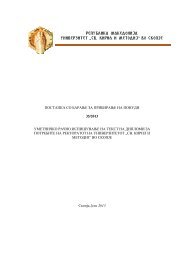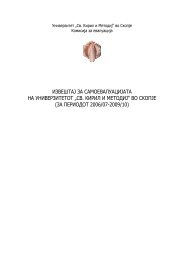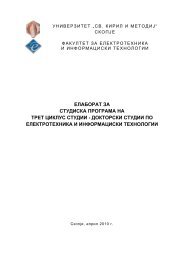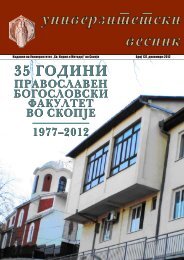УНИВЕРЗИТЕТ „СВ. КИРИЛ И МЕТОДИЈ“ – СКОПЈЕ
УНИВЕРЗИТЕТ „СВ. КИРИЛ И МЕТОДИЈ“ – СКОПЈЕ
УНИВЕРЗИТЕТ „СВ. КИРИЛ И МЕТОДИЈ“ – СКОПЈЕ
Create successful ePaper yourself
Turn your PDF publications into a flip-book with our unique Google optimized e-Paper software.
155<br />
from the perspective of Slavic languages. For instance, the word măčíhte, written<br />
ματζε̮ίχτε, reflects both the shortcomings and the redundant features of the<br />
Greek writing system. For instance, there is no way of denoting the vowel /ă/<br />
and the affricate /č/ in the Greek alphabet. As a consequence, to denote the palato-alveolar<br />
nature of the affricate, the author uses the grapheme in expressing<br />
/ă/ and the graphemes τ and ζ together with a ‘palatal arc’ under the<br />
next vowel. But then again, the redundant features of the Greek alphabet are<br />
also evident in the example: in regard to the Modern Greek pronunciation, to<br />
express the phoneme /i/, the writer has five alternative vowels or ancient diphthongs.<br />
All five of these graphemes or digraphs occur in the Konikovo Gospel<br />
and are used to express /i/ only.<br />
To express word stress, the author employs the acute accent and the<br />
circumflex, which are both used also in the Greek polytonic writing system.<br />
These two diacritical marks are used in Modern Greek to express word stress,<br />
but they do not carry any other phonetic information. However, in at least one<br />
case in the Macedonian part of the Konikovo Gospel, the writer uses these<br />
marks in a way that might have some phonological relevance (c.f. Chapter 2,<br />
phoneme /ă/). Though the variation in the use of these two accents is mainly<br />
redundant in regards to the Slavic phonology, it is nevertheless not random.<br />
To a great extent, the Macedonian text also seems to follow the Greek orthography.<br />
However, instead of speaking about orthography, it is wiser to use the<br />
term “Greek graphotactics” when talking about the Macedonian part of the<br />
manuscript, as the Greek orthography includes rules that are only applicable<br />
in the context of Greek grammar.<br />
The Church Slavonic influence on the Konikovo Gospel is most evident<br />
in the use of the grapheme in the word νεδελ (nedel’a). 2 In addition, the<br />
writer uses a ligature to conjoin the to the graphemes . Also, the<br />
use of the graphemes and to represent the sounds [g] and [d] can be<br />
seen as a Church Slavonic feature (Nuorluoto 2006).<br />
3. The Writing System of the Konikovo Gospel<br />
My aim here is to describe the writing system of the Konikovo Gospel<br />
by presenting the graphemes that are used to depict each phoneme of the hypothetical<br />
phoneme inventory. Some problems concerning vowel reduction will<br />
also be discussed, and wider problems that involve more than one phoneme are<br />
addressed when they first appear. Nevertheless, all Greek letter combinations<br />
used in the manuscript will not be treated in this paper.<br />
2<br />
occurs only a few times, though, and only in the headings.<br />
3<br />
The grapheme combines actually with a superposed , representing the digraph with<br />
the phonetic value [u].






